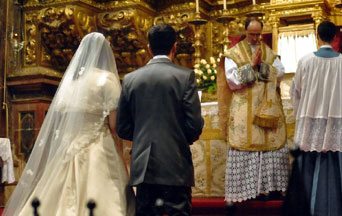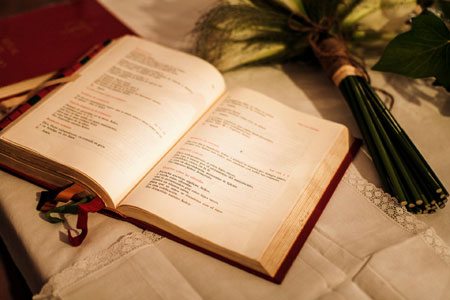
With the coming of summer, Catholics everywhere are getting married as they have from time immemorial. It is not only the fact they are getting married that has remained unchanged but also the manner by which couples tie the knot at the altar.
This is curious in light of the whirlwind of radical changes that swept liturgy and practice in the Catholic Church over the last decades. However, brides still march down the aisle much like those in the time of their parents. Likewise, they pronounce their vows before a priest in similar fashion.
Indeed, while the institution of marriage itself has suffered in a culture that has made divorce and adultery acceptable, the idea of a traditional wedding endures.
Learn All About the Prophecies of Our Lady of Good Success About Our Times
A Revolution That Changed Things
Was this lack of change an oversight? In a liturgical revolution in which nothing was left to chance, it seems improbable. In fact, what most people do not realize is that radical changes were issued. Thankfully, many today are unfamiliar with the radical new ideas that sought to adapt the wedding ceremony to modernity.
However, the fact remains that the heady reformers in the sixties were quick to declare the traditional usages and old rites hopelessly outdated. They decided the old ceremony would have to go since it was not people-oriented or feminist-friendly. It is no surprise that they came up with their own rites.
What Was Changed
Here is an idea of what the new marriage ceremony should have been.
Perhaps the most radical change was the bride’s procession into the church that is one of the most cherished parts of the ceremonial. In the new rite, the father does not give the bride away since it supposedly represents a “patriarchal” mindset that the modern church no longer accepts. In giving the bride away, the father transfers to the prospective husband the responsibility of protection and support of his daughter. The white bridal veil over the face of the bride in the procession was also not included since it signifies purity and virginity that are sadly no longer assumed today.
In place of these time-honored traditions, the new rites would have both the bride and the groom entering the church at the same time, symbolizing their equal role in making the marriage work. The priest would not need to wait at the altar but could also process in together with the couple. In the new ceremony, the emphasis was on equality and the active role of the community in supporting the marriage.
The vows were not spoken turned toward God in the Blessed Sacrament but rather facing the congregation. The bride and groom did not look at each other during this solemn moment but to the community. The insinuation was that the Christian community was the marriage’s validating institution.
Equality was accentuated even more by the couple pronouncing their own vows instead of repeating the words after the priest, who now became a mere silent witness to the marriage. The new rite’s advocates claimed all these changes were more scripturally sound than the old rite.
Changes Were Made

Of course, while the new rites failed to catch on, it would be inaccurate to say that the whole ceremony remained the same. The Nuptial Mass certainly followed the trend of modern liturgy. The choice of readings was expanded. Modern translations were made. All sorts of options and sequences were introduced into the ceremony that reflected more modern practice.
However, the traditional bridal procession and the promise ceremonial that characterized weddings from time immemorial did prevail and the new options regarding these very basic parts of the ceremony were largely ignored.
Indeed, as the twentieth century ended, liturgists were still engaged in selling the new rites to the leery faithful. In 2000, for example, a video was produced by Liturgy Training Publications for the Archdiocese of Chicago to make Catholics aware of the availability of the updated ritual that had not yet caught on.
What Happened to the New Rite
Some might ask why these unknown new rites failed to be implemented. The answer is found in one word: they were made “optional.” Though supplied, there was never a demand for them.
Unlike other reforms that were imposed, couples were given a choice, and the immense majority opted out, choosing the traditional wedding ceremony. The expected clamor for updated rites never materialized. And this is only logical since artificial norms like these have no organic connection with cultures and traditions. The profound symbolism that permeates the old rites was distilled over centuries and resonates everywhere. In the end, the ceremony turned toward God, not the community, won out, and today no one talks about the attempted egalitarian procession and promises suggested by the reformers.
Admission of Defeat
Church officials have implicitly been forced to acknowledge the failure of their aggiornamento. Most Catholic marriages performed in English have all been done according to the deeply entrenched customs of the past. When new norms were recently issued, they still leave the option open for the new usages but they are careful to accommodate those who want tradition. In fact, the new rites, which begrudgingly allowed for a traditional option, have now become the rare option.
America’s Catholic bishops have issued a new translation and instructions following new norms found in the Roman Missal implemented in 2011. These new norms go a step further by curiously allowing for other old traditions and customs that make weddings special. For example, the ancient Spanish custom of the groom handing thirteen gold coins to the bride who returns them. The coins (called las arras), represent his promise to provide for his new family, and her trust in his ability to do so.
The present text of the revised rites is deliberately vague about the traditional practices. However there is a clause that leaves leeway for couples to have a ceremony “in the customary manner.” This all but insures that the ancestral wedding opening will be the preferred option.
There is a lesson to be learned in all this. The Church is a Mother and has always taken wholesome elements of different cultures, improved upon them, and incorporated them into Her liturgy and rites. This can be seen in popular hymns, devotions… and wedding practices. The story of the modern Catholic wedding rites that never became popular is typical of what happens when organic norms and established tradition are disregarded. In such cases, the new “updated” replacement must be either imposed from the top down or, when made optional, it is ignored and forgotten.

